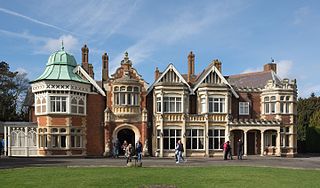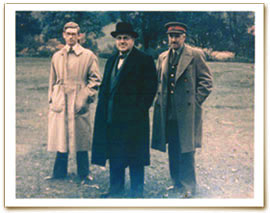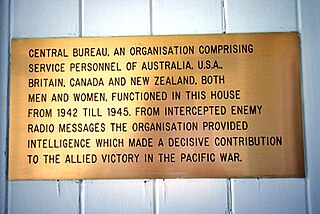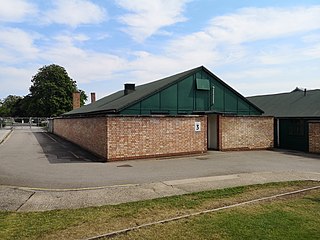Related Research Articles

Bletchley Park is an English country house and estate in Bletchley, Milton Keynes (Buckinghamshire) that became the principal centre of Allied code-breaking during the Second World War. The mansion was constructed during the years following 1883 for the financier and politician Sir Herbert Leon in the Victorian Gothic, Tudor, and Dutch Baroque styles, on the site of older buildings of the same name.

Fish was the UK's GC&CS Bletchley Park codename for any of several German teleprinter stream ciphers used during World War II. Enciphered teleprinter traffic was used between German High Command and Army Group commanders in the field, so its intelligence value (Ultra) was of the highest strategic value to the Allies. This traffic normally passed over landlines, but as German forces extended their geographic reach beyond western Europe, they had to resort to wireless transmission.
The vulnerability of Japanese naval codes and ciphers was crucial to the conduct of World War II, and had an important influence on foreign relations between Japan and the west in the years leading up to the war as well. Every Japanese code was eventually broken, and the intelligence gathered made possible such operations as the victorious American ambush of the Japanese Navy at Midway in 1942 and the shooting down of Japanese admiral Isoroku Yamamoto a year later in Operation Vengeance.
Cryptography was used extensively during World War II because of the importance of radio communication and the ease of radio interception. The nations involved fielded a plethora of code and cipher systems, many of the latter using rotor machines. As a result, the theoretical and practical aspects of cryptanalysis, or codebreaking, were much advanced.
Alfred Dillwyn "Dilly" Knox, CMG was a British classics scholar and papyrologist at King's College, Cambridge and a codebreaker. As a member of the Room 40 codebreaking unit he helped decrypt the Zimmermann Telegram which brought the USA into the First World War. He then joined the Government Code and Cypher School (GC&CS).

Hut 8 was a section in the Government Code and Cypher School (GC&CS) at Bletchley Park tasked with solving German naval (Kriegsmarine) Enigma messages. The section was led initially by Alan Turing. He was succeeded in November 1942 by his deputy, Hugh Alexander. Patrick Mahon succeeded Alexander in September 1944.

Sir Francis Harry Hinsley, was an English intelligence officer and historian. He worked at Bletchley Park during the Second World War and wrote widely on the history of international relations and British Intelligence during the Second World War. He was known as Harry Hinsley.
MI1 or British Military Intelligence, Section 1 was a department of the British Directorate of Military Intelligence, part of the War Office. It was set up during World War I. It contained "C&C", which was responsible for code breaking.
Station CAST was the United States Navy signals monitoring and cryptographic intelligence fleet radio unit at Cavite Navy Yard in the Philippines, until Cavite was captured by the Japanese forces in 1942, during World War II. It was an important part of the Allied intelligence effort, addressing Japanese communications as the War expanded from China into the rest of the Pacific theaters. As Japanese advances in the Philippines threatened CAST, its staff and services were progressively transferred to Corregidor in Manila Bay, and eventually to a newly formed US-Australian station, FRUMEL in Melbourne, Australia.

The Central Bureau was one of two Allied signals intelligence (SIGINT) organisations in the South West Pacific area (SWPA) during World War II. Central Bureau was attached to the headquarters of the Supreme Commander, Southwest Pacific Area, General Douglas MacArthur. The role of the Bureau was to research and decrypt intercepted Imperial Japanese Army traffic and work in close co-operation with other SIGINT centers in the United States, United Kingdom and India. Air activities included both army and navy air forces, as there was no independent Japanese air force.

Oliver Strachey CBE, a British civil servant in the Foreign Office, was a cryptographer from World War I to World War II.
Hugh Rose Foss was a British cryptanalyst. At Bletchley Park during World War II he made significant contributions both to the breaking of the German Enigma code and headed the section tasked with breaking Japanese Naval codes.
The "Y" service was a network of British signals intelligence collection sites, the Y-stations. The service was established during the First World War and used again during the Second World War. The sites were operated by a range of agencies including the Army, Navy and RAF plus the Foreign Office, General Post Office and Marconi Company receiving stations ashore and afloat. There were more than 600 receiving sets in use at Y-stations during the Second World War.
Before the development of radar and other electronics techniques, signals intelligence (SIGINT) and communications intelligence (COMINT) were essentially synonymous. Sir Francis Walsingham ran a postal interception bureau with some cryptanalytic capability during the reign of Elizabeth I, but the technology was only slightly less advanced than men with shotguns, during World War I, who jammed pigeon post communications and intercepted the messages carried.
The 1943 BRUSA Agreement was an agreement between the British and US governments to facilitate co-operation between the US War Department and the British Government Code and Cypher School (GC&CS). It followed the 1942 Holden Agreement.

Cuthbert Wilfrid Francis Noyce was an English mountaineer and author. He was a member of the 1953 British Expedition that made the first ascent of Mount Everest.

The Far East Combined Bureau, an outstation of the British Government Code and Cypher School, was set up in Hong Kong in March 1935, to monitor Japanese, and also Chinese and Russian (Soviet) intelligence and radio traffic. Later it moved to Singapore, Colombo (Ceylon), Kilindini (Kenya), then returned to Colombo.

Hut 3 was a section of the Government Code and Cypher School (GC&CS) at Bletchley Park during World War II. It retained the name for its functions when it moved into Block D. It produced military intelligence codenamed Ultra from the decrypts of Enigma, Tunny and multiple other sources. Hut 3 thus became an intelligence agency in its own right, providing information of great strategic value, but rarely of operational use. Group Captain Eric Malcolm Jones led this activity from 1943 and after the war became deputy director, and in 1952 director of GCHQ. In July 1945, General Dwight D. Eisenhower Supreme Commander of Allied forces wrote to Sir Stewart Menzies, Chief of the British Secret Intelligence Service (MI6) saying inter alia:
"The intelligence that has emanated from you before and during this campaign has been of priceless value to me. It has simplified my task as commander enormously. It has saved thousands of British and American lives and, in no small way, has contributed to the speed with which the enemy was routed and eventually forced to surrender."
Japanese army and diplomatic codes. This article is on Japanese army and diplomatic ciphers and codes used up to and during World War II, to supplement the article on Japanese naval codes. The diplomatic codes were significant militarily, particularly those from diplomats in Germany.
References
- Smith, Michael (2000). The Emperor’s Codes: Bletchley Park and the breaking of Japan’s secret ciphers. London: Bantam Press. ISBN 0593 046412.
- Smith, Michael; Erskine, Ralph, eds. (2001). Action this Day. Bantam London. ISBN 0-593-04910-1.
- Elphick, Peter (1998) [1997]. Far Eastern File: The Intelligence War in the Far East 1930-1945. London: Hodder & Stoughton. ISBN 0 340 66584 X.
28°41′8.6640″N77°12′22.9788″E / 28.685740000°N 77.206383000°E